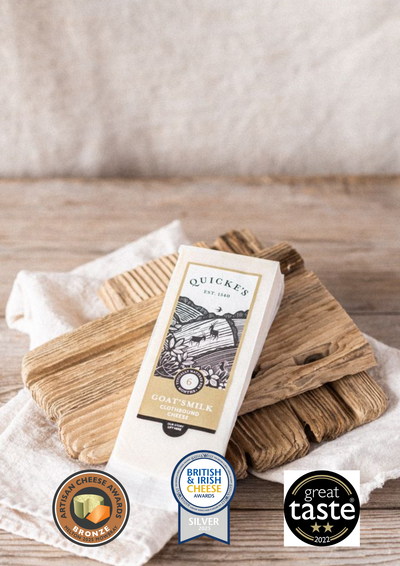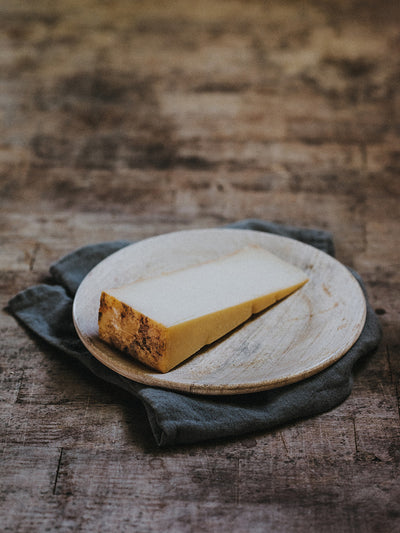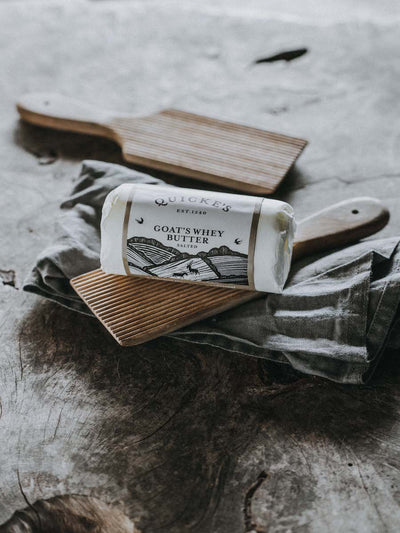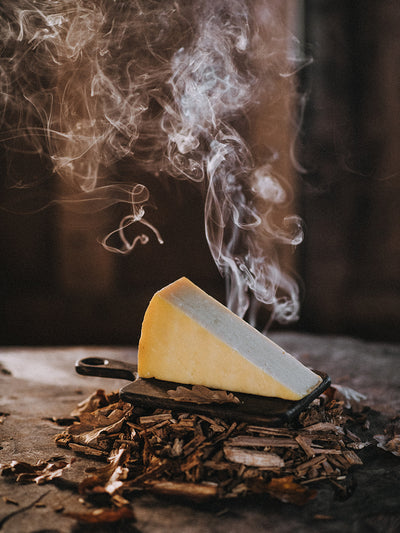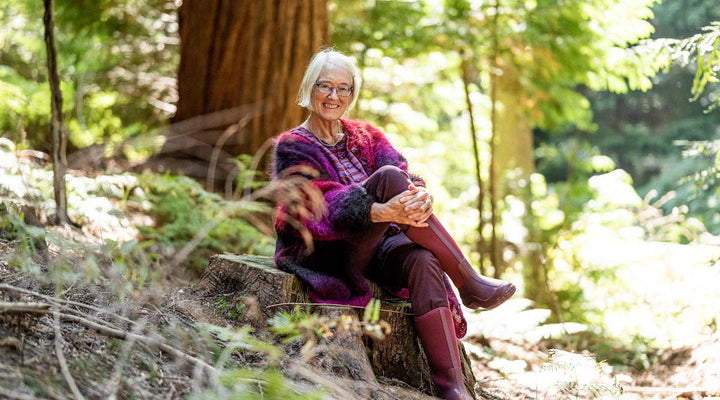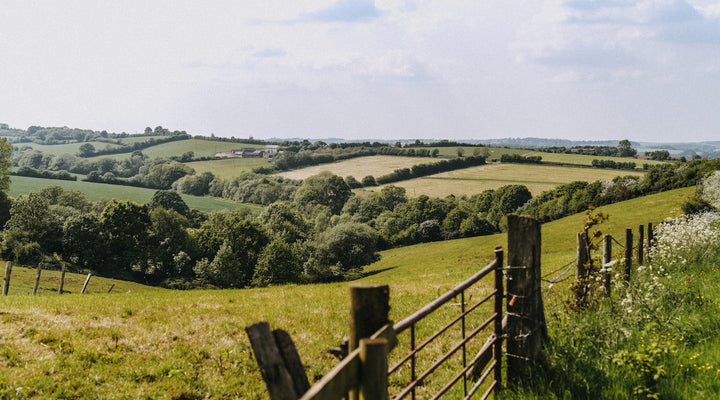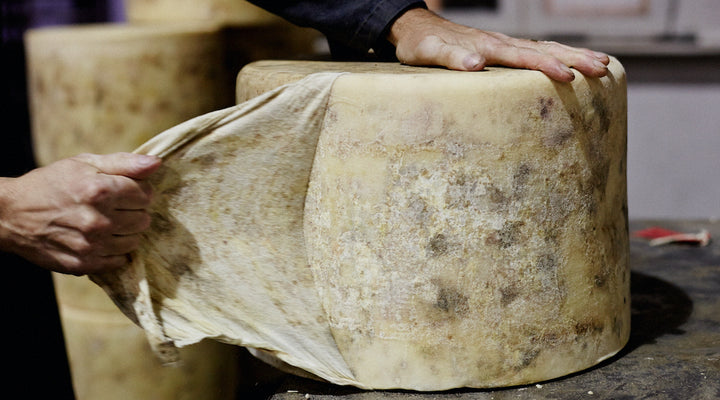What a year it’s been! I’m so grateful for the support we’ve received from round the world, from individuals and from the businesses that love our cheese. Now smart people are saying expect a pandemic not once a century but rather more often given the way people are pressing into the wild places of the world. It really is time now to value the miraculous and unknowable complexity that keeps our blue planet a nurturing home to people.
ON THE FARM
On the farm we are working out how we can maintain and enhance our biodiversity, at the same time as reducing our greenhouse gas emissions. Our land is about half woodland. My father planted trees from the 1950’s onwards which are now gracious, mature, cathedral-like, great columns reaching up into the sky. The plan had been when they were planted to start felling all in an area and plant again. Now we see that the mature trees are starting to grow little seedlings. We can maintain the forest cover, and selectively harvest trees, leaving mother trees to nurture their young, Avatar-like. (The film was based on real scientific research about how trees maintain communication through an underground mycorrhizal network). That way, the forest keeps gaining carbon at its peak rate. The other part of the woodland is biodiverse ancient woodland, hedges and oak coppice planted after the dropping of tariff barriers and opening up of the American prairies made farming on much of the farm uneconomic. Rewilding happened on a massive scale: my father as a little boy in the 1920’s spoke to an old man, who as a boy in the 1870’s had led the horses that sowed the acorns across the parts of the land no longer worth farming. We manage some, and thin the oaks to make a crop of timber or firewood. Unmanaged woodland don’t take carbon out of the air, it’s in a steady state of growing and decaying. Both are richly biodiverse. We are happy not to crop it fully for its beauty and biodiversity.
Our grassland, the heart of our farming, makes a rich ecosystem of roots and associated life that grows the herbage the cattle eat, and which they manure as they graze. The organic matter increases in the soil under grass. Some of our pastures are more lightly grazed and biodiverse, in orchards and in wetter corners. The woodland margins are beautiful and biodiverse.
We grow crops on land that has had a restorative grassland break. The crop uses organic matter made by the grassland roots to grow, saving artificial fertiliser. Arable cropping on its own is hard on soils, harvesting organic matter, and over time reducing their structure and ability to grow crops.
The animals can’t graze in the depths of winter, and outwintering is harsh on soils and people. The straw we grow beds the animals and the crops feed them. We sell some to buy cow feed. Cow feed is largely made out of the kind of wheat and barley we grow here, not suitable for bread or flour (not enough protein in it, with our damp climate), plus residues from human food (pulp from pressing sugar beet, husks from refining flour and cornmeal, and what’s left after crushing seeds for oil). We sow or leave some areas for wildlife: seeds to feed wild birds over winter, margins round fields and hedges to make wildlife lanes across the landscape. We are working with the Farming and Wildlife Advisory Group to work out how best to farm to balance making a living, sensible working for people and animals, storing carbon, and biodiversity.
If you have grassland, you need animals to eat them, making meat and milk for us, and manuring the ground to feed the roots. Ruminant animals eat the fibre we can’t digest. It’s the bugs in their rumens that do the digesting and produce methane along the way. For us that’s our biggest contribution to global warming. Our woodland sequesters half of that, making our milk about the same carbon intensity as rice milk. Improvements in soil organic matter mean we reduced our greenhouse gas emissions by 2% last year. To get to net zero by 2030, our aim, we must do 10%+ a year.
We are working out what the best balance of added feed and yield to optimise carbon. We are demanding our feed company provide feeds which don’t reduce yield for the methane produced. We also don’t want the cows to be producing other harmful gases. Feeding seaweed, which looked promising, might have the animals produce methyl bromide, that harms the ozone layer as well as being very heating. We are using the Envirocow breeding index to reduce carbon intensity of future generations of animals. At the moment that is largely efficiency: amount of milk for size of cow and length of life (to dilute methane from the rearing phase). We’ll capture some methane from cow poo to fuel our cheese dairy and a bit more solar PV. We need the scientists to breed differences in how animals’ rumens work. More than that: scientists must tell us the best balance in the whole system of soil, plants, animals, people, wildlife and use of fossil fuels. That’s so complex. We can’t wait for that work to happen. We must take action now, and keep our eyes wide open when greater understanding or clever bits of kit change the calculation. I’ll let you know as we develop our plans.
IN THE CHEESE DAIRY
We are still making cheese as fast as we can to satisfy demand for our cheese. We are making more little 1.8kg cheese to replace the ones we are selling for a spectacular gift and a show-stopping addition to any festive feast. We are packing cheese up as fast as we can for Christmas cheeseboards. And we need to do all the work to have next year’s cheeses made, cared for and matured. I’m so grateful for all the support we’ve received from round the world, from individuals and from the businesses that love our cheese. Let’s all work to build back better as we all balance great food and environment.
MY CHRISTMAS FEAST
On the days of Christmas I feast on carp, goose, and ham in the evening. Lunch is piling onto the table our cheeseboard, cured fish (I make a mean gravad lax), cured meats, preserved and fermented vegetables, a great sourdough bread and salad with the last roses from the garden. My favourite cheeseboard rotates, with a Tunworth or Baron Bigod, a Colston Basset Stilton and fresh cheese from White Lake like Eves and Tors. For Christmas, I have a good wedge of our Vintage Cheddar to hit the buttery umami spot, and AlpenCheddar for the stinky hit. I love those delicate bone dry white or fizz from Calancombe Estate . They cut through the salt, fat and protein of lunch, and light enough to encourage an afternoon walk with the family in the watery sunlight of Christmas.
Gravad Lax recipe:
1.Get a good chunk of mid salmon, filleted, with both sides. I leave the skin on: it holds better when slicing.
2.Mix (for 1.5kg fish, scale up with the weight of the fish) 1 heaped tablespoon of sea-salt, a dessert spoon of honey, a heaped teaspoon of roughly crushed black pepper and a good tablespoon of cognac.
3. Rub the salt mix on one side of the skin. Lay the fish in the smallest dish that will hold it, rub half the salt mix on the inside surfaces of the fish. Press the two sides of the fish together with fresh or dried dill between them.
4.Rub the remaining salt mix on the top surface. Cover with silver foil. Put a plate on that can weigh down on the fish as the moisture comes out. Put the heaviest weight you can find on the plate -that’s important: if it’s not weighted, it becomes unpleasantly salty.
5.Put in the fridge for at least 36 hours, turning fish over every 12 hours.
6. When you want to eat it, remove from the curing mix, which you discard. Scrape the pepper and dill off. Slice thinly, eat as part of your preserved food feasting.
Wishing you a Merry Christmas and a Happy New Year!
Mary Quicke

